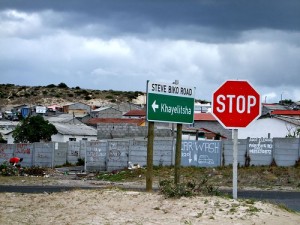Critique: unfortunate undertones in a solid documentary series

The students featured in the School Year series live in the low-income township of Khayelitsha. Photo: Brandon Jones, Creative Commons, some rights reserved
I was recently sitting in my kitchen, half listening to The World while eating dinner.
This piece came on and grabbed my full attention. I stared at the radio until it ended.
The story was part of a series called “School Year: Learning, Poverty, and Success in a South African Township.” This is the project of Anders Kelto, who is The World’s Cape Town-based Africa Correspondent. In the year-long series, which began in March, Kelto checks in with low-income students who attend a prestigious high school, the Centre of Science and Technology (COSAT).
Based on the School Year stories I’ve checked out so far, the series is pretty cool. We really get up close and personal with these students. Kelto doesn’t shy away from the veritable horrors that are part of everyday life in Khayelitsha (like in this piece, which I loved). There’s even an interactive element, too: some of the students have been speaking directly with their audience on Facebook. I admire that – it prevents the series from being an exhibit for faraway audiences to gawk at.
One of the students is Tandie Nkosi. In “From the shacks to the prom, a South African girl’s night of glamour”, we follow her as she gets ready for, and then attends, her high school prom. This is a big deal, because – well, because it’s prom. But especially because Tandie had to save up for months to afford shoes, a dress, and the prom ticket. In her voice, we can hear how important this is, and we’re rooting for her from the start.
What I think spoils the piece is Kelto’s heavy-handed narration. It’s not really his story to tell – it’s Tandie’s, but his voice overpowers hers. And there’s this other thing – an unfortunate side effect of the narration style and tone, I think. Kelto makes Tandie’s visit to the hair salon, her preparations, her display of the dress, and prom night itself, sound like novelties.
For a radio story (or any story) to work, there is usually some kind of conflict. For Kelto, it seems like the conflict is this: She wants to go to prom, but she is poor. Okay, sure. I think he should have stopped right there. He plays up the wealth/poverty dichotomy so much that it’s distracting. And worse, it doesn’t even feel like that’s the real story. To me, the real story is that she’s going to prom, which is a special treat she’s worked hard for, and it’s going to be awesome. The night itself will also be a rare time when she won’t have to think about her financial situation. But Kelto, unlike Tandie, is so focused on Tandie’s poverty, and that feels inappropriate.
But what do I know? I was not there. Tandie’s version might be exactly the same as Kelto’s. Even so, the piece was jarring – perhaps, because she didn’t tell it herself. This was Anders Kelto’s interpretation of what transpired, and something about his presentation felt a little unreliable.
When I heard this story, I had in mind a recent episode of HowSound, which is my former instructor’s podcast. The episode features Catherine Stifter and jesikah maria ross (she doesn’t capitalize her name), who lead a documentary program called “The View From Here.” The program has a unique and radical approach. They go the extra mile to make sure their stories ring true for the interviewees, partly by letting them do most of the talking. Their goal, as Stifter says, is to put an end to
the pretense we that we have that we – mostly white, educated reporters – go out and point our microphones at something, and then we, tell you what we’re gonna tell you, we tell you what we told you, and then we tell it to you again.
We think that our audience is way smarter than that… And there’s kind of a different way to bring those stories to people: to include the storytellers, and the cultural experts in these stories, and to allow them to have their scene. To allow that scene to play out, and to not interrupt. We’re not the people who need to translate how that is, or what it is, or what it means to them.
The non-narrated (or minimally narrated), scene-driven stories that Stifter and ross produce represent an extreme. Public radio news is not going to jump to that extreme any time soon – and it probably shouldn’t. Those kinds of stories probably don’t transmit “hard news” information fast enough. However, I do think news spots are more powerful – and more human – when they slow down and let those scenes play out, at least for a little bit longer than what is customary. I think slower radio does a slightly better job of answering the question: Whose story is it, really?
Tags: anders kelto, critique, howsound, ncpr, school year, south africa, the world, undertones, zach hirsch






.png)

Thanks, Zach. Good analysis.
Media introspection, where the heck else are you going to see that?